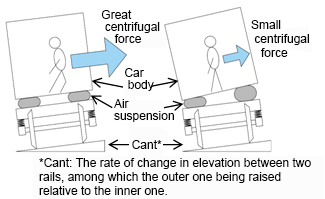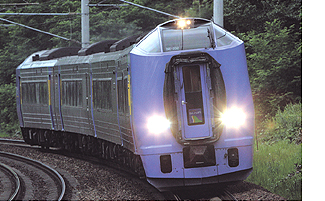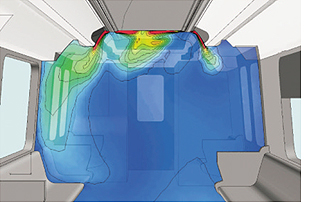Improving Ride Quality
The ride quality of rolling stock depends on a variety of factors, including vibration, temperature, illuminance, noise, and the cleanliness of the vehicle's interior. This section describes KHI's technology for tilting car bodies and mitigating centrifugal force on curved track segments and its technology for reducing the vehicle interior noise.
Technology for Tilting Car Bodies
During high-speed travel on a curved track segment, passengers feel like they are being pulled outward because of the centrifugal force exerted on them, which compromises the ride quality. KHI mitigates this outward pull by tilting the car body on the bogie toward the center of the curve. Developed by KHI, this system is used for Shinkansen and conventional express trains due to its low initial and maintenance costs and its superior reliability.

Schematic illustration of a car body tilting unit

KiHa 261 series train equipped with a car body tilting unit
Technology for Reducing Vehicle Interior Noise
One source of noise inside a vehicle is the air conditioning. This noise mainly depends on the duct shape and air velocity, but the use of increasingly complex duct shapes to make the most of the vehicle's inner space is making it hard to pinpoint the exact source.
KHI employs an aerodynamic noise analysis method based on computation fluid dynamics (CFD) to analyze and predict the distribution of noise sources. This enables us to reduce the vehicle interior noise by optimizing the duct shape to ensure a smoother flow of air at these sources.

Results of CFD-based noise analysis





